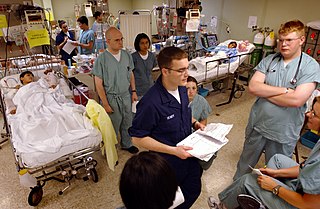
Biomedical engineering (BME) or medical engineering is the application of engineering principles and design concepts to medicine and biology for healthcare applications. BME is also traditionally logical sciences to advance health care treatment, including diagnosis, monitoring, and therapy. Also included under the scope of a biomedical engineer is the management of current medical equipment in hospitals while adhering to relevant industry standards. This involves procurement, routine testing, preventive maintenance, and making equipment recommendations, a role also known as a Biomedical Equipment Technician (BMET) or as a clinical engineer.
Medical physics deals with the application of the concepts and methods of physics to the prevention, diagnosis and treatment of human diseases with a specific goal of improving human health and well-being. Since 2008, medical physics has been included as a health profession according to International Standard Classification of Occupation of the International Labour Organization.

Medical research, also known as health research, refers to the process of using scientific methods with the aim to produce knowledge about human diseases, the prevention and treatment of illness, and the promotion of health.
Translational medicine develops the clinical practice applications of the basic science aspects of the biomedical sciences; that is, it translates basic science to applied science in medical practice. It is defined by the European Society for Translational Medicine as "an interdisciplinary branch of the biomedical field supported by three main pillars: benchside, bedside, and community". The goal of translational medicine is to combine disciplines, resources, expertise, and techniques within these pillars to promote enhancements in prevention, diagnosis, and therapies. Accordingly, translational medicine is a highly interdisciplinary field, the primary goal of which is to coalesce assets of various natures within the individual pillars in order to improve the global healthcare system significantly.

The Academy of Medical Sciences is an organisation established in the UK in 1998. It is one of the four UK National Academies, the others being the British Academy, the Royal Academy of Engineering and the Royal Society.
The Harvard–MIT Program in Health Sciences and Technology, or HST, is one of the oldest and largest biomedical engineering and physician-scientist training programs in the United States. It was founded in 1970 and is the longest-standing collaboration between Harvard University and the Massachusetts Institute of Technology (MIT). Within the program, graduate and medical students are registered with both MIT and Harvard and may work with faculty and affiliated faculty members from both communities. HST is a part of MIT's Institute for Medical Engineering and Science and forms the London Society at Harvard Medical School.

Clinical engineering is a specialty within biomedical engineering responsible for using medical technology to optimize healthcare delivery.

The Institute of Physics and Engineering in Medicine (IPEM) is the United Kingdom's professional body and learned society for physicists, engineers and technologists within the field of medicine, founded in 1995, changing its name from the Institution of Physics and Engineering in Medicine and Biology (IPEMB) in 1997. The Institute is governed by an elected Board of Trustees reporting to which are the Science, Research and Innovation Council and the Professional and Standards Council. The councils have operational responsibility for scientific and professional aspects of the Institute's work, respectively. Beneath the councils is a substructure of committees, groups and panels of members, which undertake the work of the Institute.

Shahed University is a public university in Tehran, Iran. The campus is located in the southern part of Tehran along the Persian Gulf Freeway. Founded in 1990, the university started its activities by accepting 165 students in seven disciplines in 1991. It now has 10,000 students enrolled in 100 programs, 8 faculties, and 7 research institutions.
Critical Reviews in Biomedical Engineering is a bimonthly peer-reviewed scientific journal published by Begell House covering biomedical engineering, bioengineering, clinical engineering, and related subjects. The editor-in-chief is Chenzhong Li.
Translational research is research aimed at translating (converting) results in basic research into results that directly benefit humans. The term is used in science and technology, especially in biology and medical science. As such, translational research forms a subset of applied research.

The International Federation of Medical and Biological Engineering (IFMBE) was initially formed as International Federation for Medical Electronics and Biological Engineering during the 2nd International Conference of Medical and Biological Engineering, in the UNESCO Building, Paris, France in 1959. It is primarily a federation of national and transnational organizations. These organizations represent national interests in medical and biological engineering.

Biomedical sciences are a set of sciences applying portions of natural science or formal science, or both, to develop knowledge, interventions, or technology that are of use in healthcare or public health. Such disciplines as medical microbiology, clinical virology, clinical epidemiology, genetic epidemiology, and biomedical engineering are medical sciences. In explaining physiological mechanisms operating in pathological processes, however, pathophysiology can be regarded as basic science.

Biomedical Optics Express is a monthly peer-reviewed scientific journal published by Optica. The journal's scope encompasses fundamental research and technology development of optics applied to biomedical studies and clinical applications. The founding and first editor-in-chief is Joseph A. Izatt. The current editor-in-chief is Ruikang (Ricky) Wang at the University of Washington, USA.

The Canadian Medical and Biological Engineering Society (CMBES) is a technical society representing the biomedical engineering community in Canada. CMBES is supported by its membership which consists of biomedical engineers, biomedical engineering technologists and students. CMBES also hosts an annual conference and regular webinars. It produces a number of publications including the Clinical Engineering Standards of Practice and a Newsletter. The Society's aims are twofold: scientific and educational: directed toward the advancement of the theory and practice of medical device technology; and professional: directed toward the advancement of all individuals in Canada who are engaged in interdisciplinary work involving engineering, the life sciences and medicine.
Science Publishing Group (SPG) is an open-access publisher of academic journals and books established in 2012. It has an address in New York City and many of its journals are named American Journal of..., but the company is actually based in Pakistan. The company has been criticized for predatory publishing practices. As of 2019, it publishes 430 journals in various fields.
SciRes Literature LLC is a publisher of academic journals. It has a postal address in Middletown, Delaware, US, but is actually based in Hyderabad, India. It started its activities in 2015. The company uses an Open Access model of publishing, which charges the authors. Articles are distributed online and free of cost or other barriers. As of October 2022, none of its journals names a scientific editor-in-chief.









